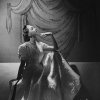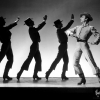Actually, there were two Maurice Seymours. The brothers Maurice Zeldman and Seymour Zeldman came to Chicago from Russia in 1920. After working for a few years for Bloom’s Studios in the State-Lake Building (“Bloom was the Maurice Seymour of his day,” says Maurice), they launched their own studio in 1929 atop the St. Clair Hotel (now called the Inn of Chicago) on Ohio Street.
“We were in business together and ‘Maurice Seymour’ sounded better than Zeldman, so that’s how we named the business.” The brothers, Maurice and Seymour worked together for the most part, photographing the ballet, musicians and entertainers but they also worked individually some of the time. Their style of photography was pretty identical and you really can’t tell one from the other. Maurice, who operated the parent studio, at 111 E. Chicago Avenue after 26 years in the St. Clair Hotel legally changed his last name to Seymour. His brother, Seymour, also changed his name to Maurice Seymour when he moved New York and established the company’s New York City studio.
THE SAGA BEHIND THE SIGNATURE, ‘MAURICE SEYMOUR, CHICAGO’
“PANORAMA” MAGAZINE: THE CHICAGO DAILY NEWS, MAY 11, 1968
By Joseph Haas
The name of Maurice Seymour Probably has appeared in more theaters than those of the entire Barrymore family put together. It appears, somewhat small but with a distinctive flourish, in the lower left-hand corners of publicity photographs for the stars, and it’s one of the best-known names in show business.
The name, Maurice Seymour represents the two Zeldman brothers: Maurice and Seymour. They combined their first names to create the Maurice Seymour Studio.
Show business, however, isn’t Maurice Seymour’s trade. He works on the periphery as “the photographer to the celebrities.” and it is a rare American celebrity who hasn’t come before his camera. Young performers, whose stars are only in their eyes as yet, come to Seymour for photographs as sort of a talisman for better things to come. Maurice Seymour came to Chicago from Russia in 1920. After working for a few years for Bloom’s Studios in the State-Lake Building (“Bloom was the Maurice Seymour of his day,” says Maurice), he launched his own studio in 1929 atop the St. Clair Hotel.
All kinds of celebrities came before the Seymour lens – actors, politicians, comedians, singers, showgirls, judges, generals – but if Seymour is best-known for any one area of theatrical photography, it is for his ballet pictures. Two volumes of these photographs, “Seymour on Ballet” and “Ballet Portraits,” have been published over the years filled with striking portraits and studies of stars.
Maurice is a deep-chested, broad, rumpled, good-natured man with a wide face, gristly hair, and a bit of Akim Tamiroff in his voice. He handles the photography, and his wife, Sonia, manages the studio’s office. Both his sons, Ronald & Serge are photographers. The Seymours are grandparents four times over. The photographer (who says, “I’m not young,” when asked his age, undoubtedly a result of his years of dealing with show people) got his big break not long after opening the Seymour studio in 1929. Some of his photographs were displayed in the windows of the Lake Shore National Bank on Michigan Av. one day when Freeman Gosden and Charles Correll strolled past.
“Later we got a call from NBC Saying that Gosden and Correll insisted that they must have their publicity pictures taken by Maurice Seymour, says Seymour, ‘and that launched us. (Gosden and Correll, of course, were Amos \n’ Andy, the biggest stars of early radio.) Ballet became one of the most important aspects of Seymour’s business after the Ballet Russe de Monte Carlo played Chicago in 1934. Its director, Col. W. de Basil, visited the Seymour studio to arrange to have the troupe photographed. `I know these Russians,” says Seymour, “so I asked for the money in advance. We had a good laugh; the whole troupe came to the studio after a performance on night and stayed until the next morning. After that, we photographed them almost every year, and then other ballet companies began to come to me. We had some wonderful times in the studio; they would pose, dance, eat and drink all night. Those were good times.”
















